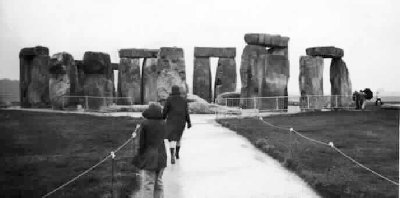Stonehenge
Today, we find mystery and education beside a road. The University of Houston's College of Engineering presents this series about the machines that make our civilization run, and the people whose ingenuity created them.
We came over the hill on a gusty wet January morning in 1975. We'd slept briefly in Dover the night before. Now we were driving to a new home in Southwest England. My family was tired. Sightseeing was far from our minds. But all at once, as we gazed out over the Salisbury plain, we saw ancient gray rings of rock under the gray sky. It was Stonehenge!
Falling unprepared into Stonehenge was like trying to recall something we'd experienced, long long ago. You ask, "What was I thinking when I built this thing?" Everything we know about Stonehenge was written after the Normans came. Since then we've asked, over and over, what those stones are trying to tell us.
In 1666, John Aubry showed that the main Stonehenge corridor aligns with sunrise, at the Summer Solstice. That fit the 17th century fascination with astronomy. Then an 18th century writer claimed Stonehenge was the work of Druids. That's utter poppycock. Druids only appear as a tiny footnote in Roman history, thousands of years later. Yet, to this day, people still imagine Druids dancing among those stones.
In 1900, Norman Lockyer realized that the position of the Solstice has varied. So he figured Stonehenge was built in 1680 BC when the alignment was perfect. But the old rocks are so badly worn that he could've been off by thousands of years.
Astronomers came back to Stonehenge armed with computers in the '60's. Now they found near alignments of stones, holes, and markers with the moon and its eclipses. Even Fred Hoyle flung his fertile mind into the game. A curious war followed. The Archaeologists were furious. They didn't have the math to challenge astronomers, but they could see facts being swept under the rug. For example, other monuments have the same features, but they don't point to the moon.
Carbon dating of artifacts at Stonehenge finally set the age of the site. Construction began in 3100 BC. Then it was built and rebuilt until 1000 BC. Today we know where Neolithic builders quarried the various stones. Some smaller pieces came all the way from Ireland.
Yet the purpose stays mysterious. If Stonehenge has features of an observatory, it also has features of a burial ground and of a temple. It hasn't explained itself, but it has taught scientists to show each other greater respect. In the end, an English archeologist writes,
This ravaged colossus rests like a cage of sand-scoured ribs on the shores of eternity, its flesh forever lost. Stonehenge grudges its secrets. Its spiraling complexity even now eludes our understanding ...
I'm John Lienhard at the University of Houston, where we're interested in the way inventive minds work.
(Theme music)
Fernie, J.D., Stonehenge and the Archaeoastronomers. Science, Vol. 78, No. 2, March-April 1990, pp. 103-105.

Photo by JHL